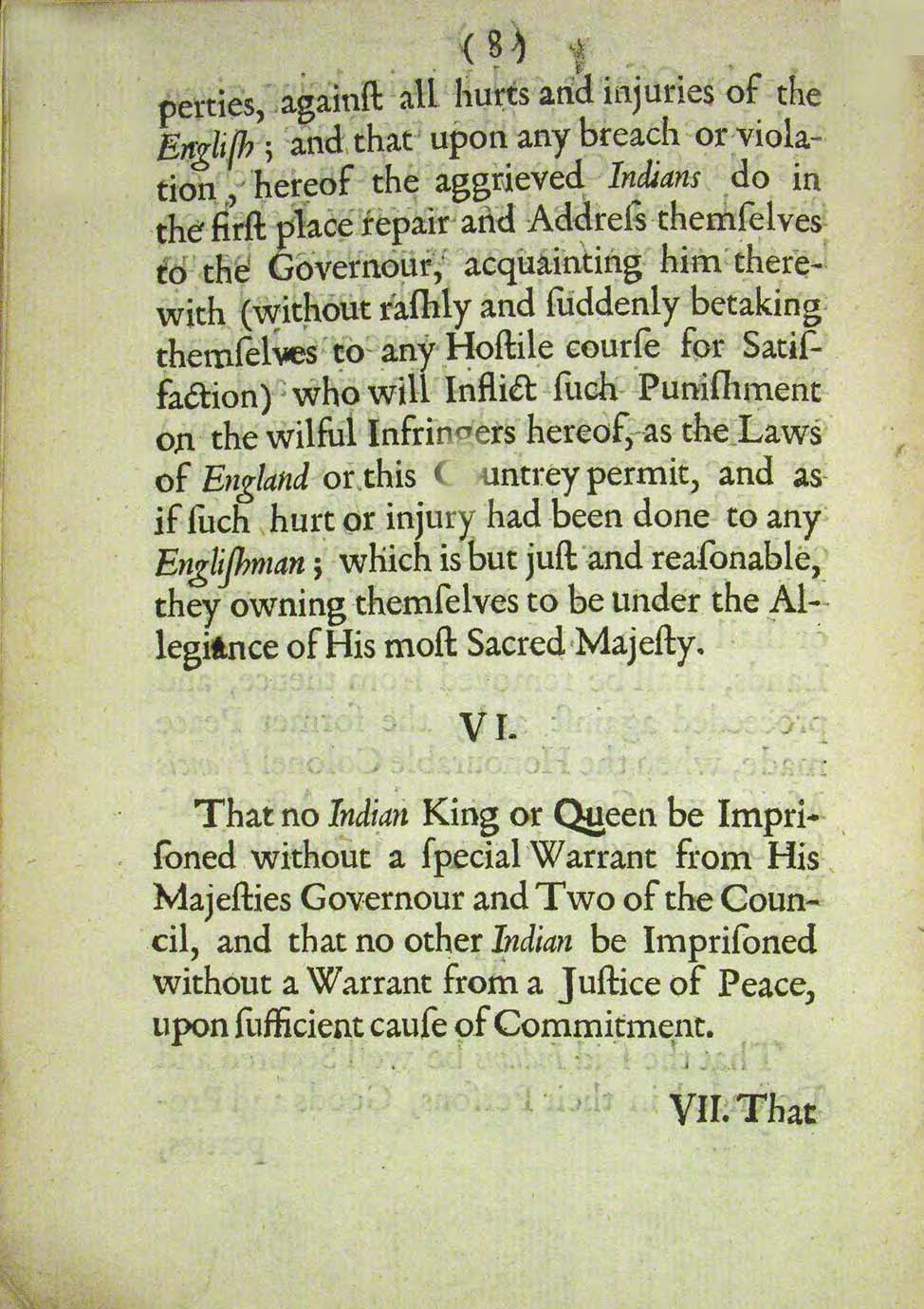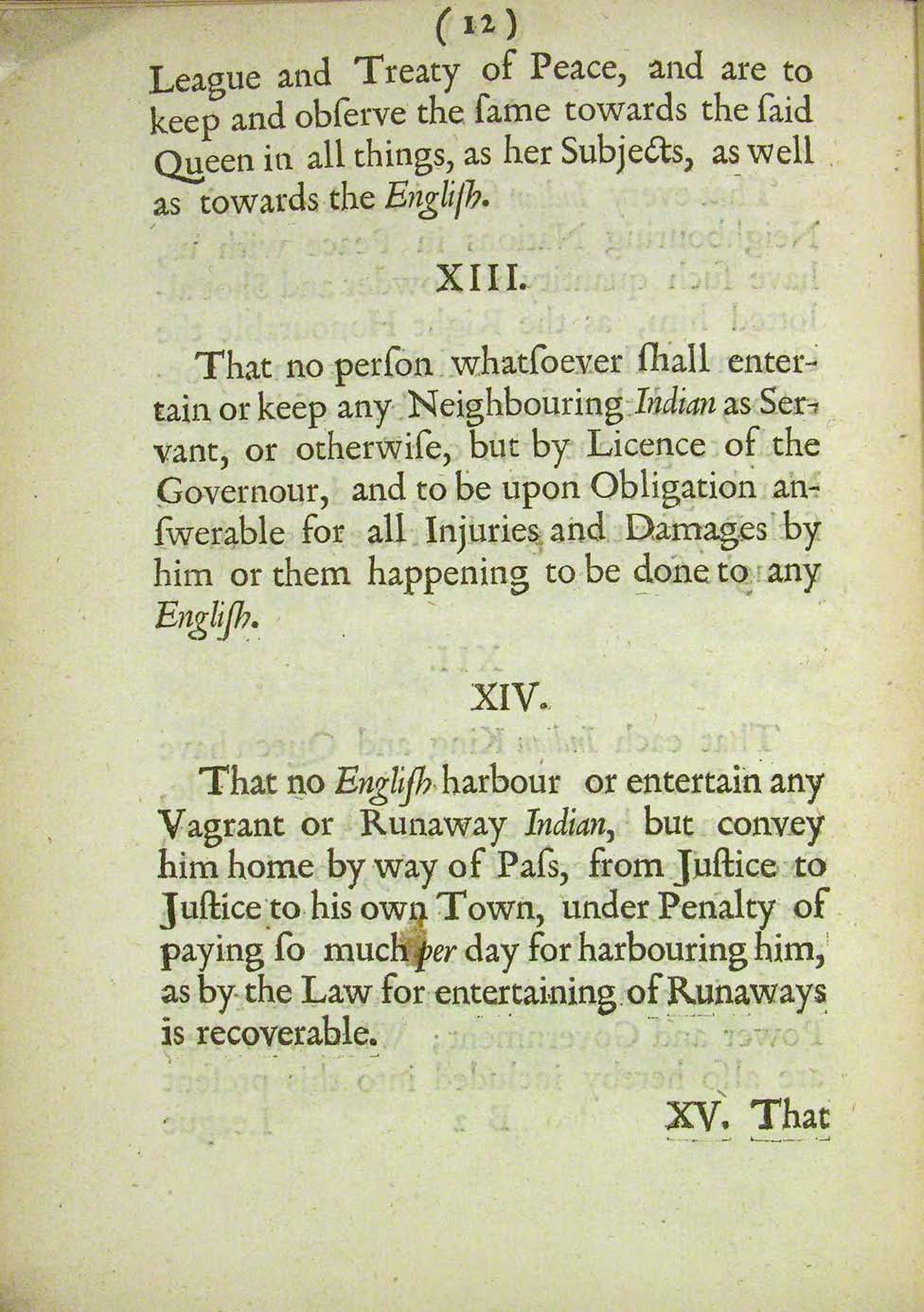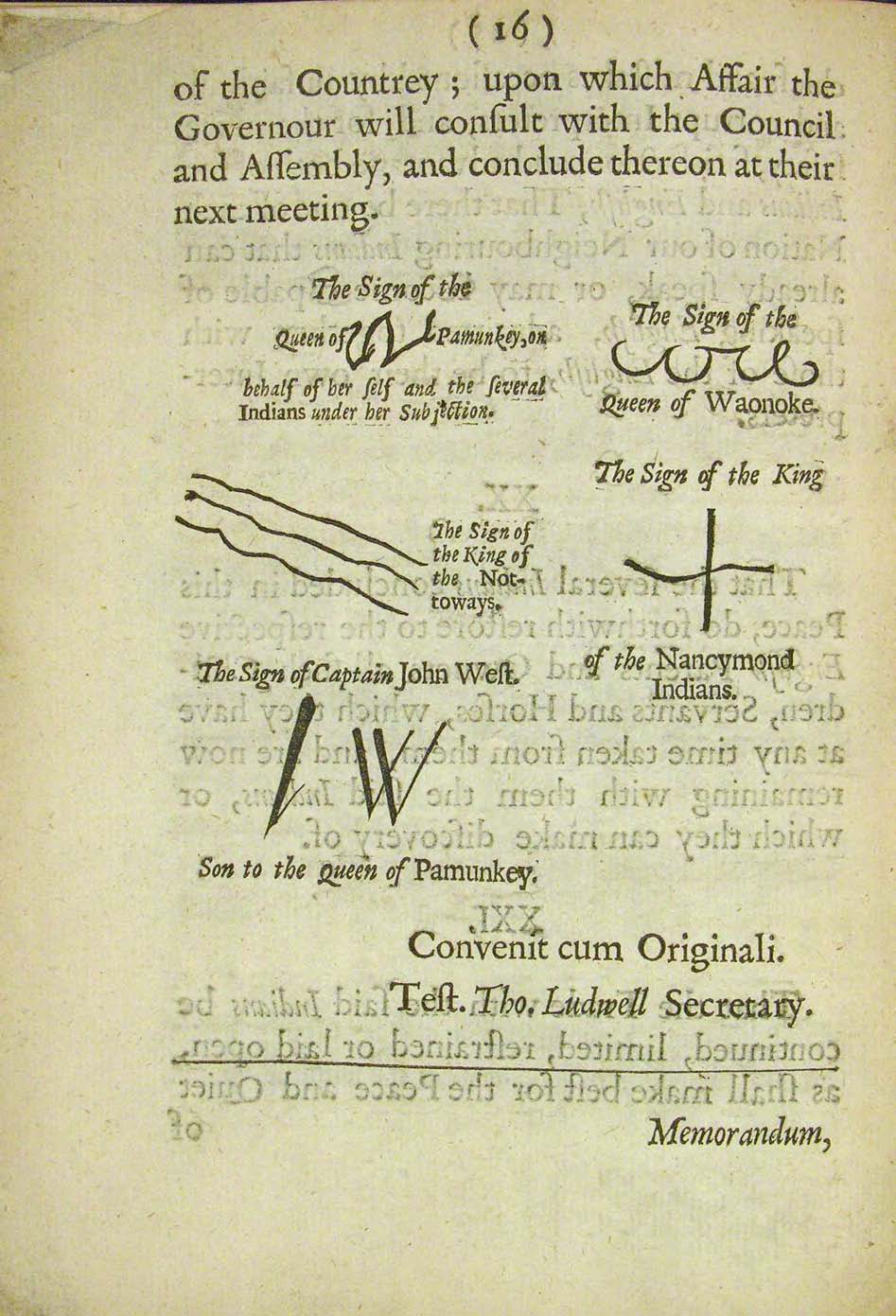Articles of Peace Between the Most Serene and Mighty Prince Charles II and Several Indian Kings and Queens ["The Treaty of Middle Plantation"]
By
Charles Stuart
Transcription, correction, and markup by Austin Benson, John O'Brien, Tonya Howe
treaty
This document, most typically remembered as the “Treaty of Middle Plantation,” after the place where it was ratified (the site of present-day Williamsburg, Virginia) was signed in May 1677 by the governor representing the English colonial government and the leaders of several indigenous tribes, primarily the Pamunkey and Mattaponi, to bring an end to a series of conflicts between the English settlers and the native people of the region. The conflicts are most often referred to as “Bacon’s Rebellion” after the English settler Nathaniel Bacon, who in 1676 led attacks against native groups and then an armed uprising against William Berkeley, then the English governor, and his administration. The Rebellion is a complicated and often ugly story, but a key component was that Bacon and the colonists who joined him in rising up against their own government, argued that Berkeley was not sufficiently brutal to the native American population in the area, which Bacon wished to eliminate completely to clear land for settlement by English colonists. Bacon’s uprising exposed divisions with the colonists between the elite members of the government (which was in favor of promoting the intersts of settlers but not interest in sparking conflict with the native people) and the farmers, indentured servants, and also some enslaved African people who fought on Bacon’s side. But the conflict also exposed and exacerbated divisions with the local indigenous nations. Bacon and his followers burned the colonial capital of Jamestown down, but he died of unexpectedly of dysentery in October 1676. The rebellion lost its momentum with the loss of its leader. The British government restored order and executed some of the other central figures in the uprising. Berkeley, who seemed unable to please anybody, was relieved of his office and went back to England, where he died in July 1677. The English king, Charles II, sent a commission consisting of John Berry and Francis Morison to investigate the situation, as well as a new governor, Herbert Jeffreys, to replace the discredited Berkeley.
The treaty to establish a durable peace was largely negotiated between the commissioners and a group of natives led by the Pamunkey leader Cockacoeske, who had become the most prominent representative of the indigenous people in the region. (We follow convention in identifying the “author” of the treaty as Charles Stuart or Charles II, as all royal proclamations and treaties were credited to him, but the terms were worked out on the ground, using language that followed legal and diplomatic precedent.) Under the terms of the treaty, the native peoples avowed their loyalty to the English crown. In return, the different tribes were recognized as sovereign over their own citizens, and were granted various kinds of protection against future attempts at violence against them by English settlers. Colonists were, for example, not allowed to claim any land within three miles of a native village. This in effect established the first reservations for indigenous people in territory that was becoming increasingly dominated by the English. The treaty also consolidated Cockacoeske, the “Queen of Pamunkey,” as the leader of the indigenous people of the area, insisting that other tribes declare their allegiance to her.
The native people probably had reason to regret the terms of the treaty. English settlers often ignored the three-mile rule, and Cockacoeske had mixed success in getting other indigenous leaders to acknowledge her authority. But the Treaty of Middle Plantation remains in force to this day. Representatives of the Mattaponi and Pamunky people bring gifts such as turkey and deer to the Governor of Virginia each year, usually around Thanksgiving, in symbolic fulfillment of their obligations for the "tribute" called for by the treaty. In theory, the Treaty of Middle Plantation protected indigenous people from acts of violence and codified their sovereignty, something that Bacon and his followers would not have accepted. But the document is also one of many that marks the long history of the displacement of native people in the Americas from the lands that they had lived on for many centuries. - [JOB]birthdayMay 29th was indeed the birthday of Charles II, as well as the anniversary of the day that he had been restored to the English throne in 1660. It is impossible to know whether this is a coincidence, or whether the English commissioners planned the treaty signing to occur on a day that they knew that their boss considered to be an auspicious one. - [JOB]tuckahoeTuckahoe is a generic name for a number of marsh grasses that indigenous people used for food and medicine. - [JOB]curtenemonsCurtunemons is the Pamunkey word for the plant that English speakers usually call "dock"; it's a green that can be used fresh in salads or cooked. - [JOB]puckooneA Pamunkey word for a plant that the indigenous people used to make a dye for clothes. - [JOB]
[Title Page]
ARTICLES
OF
PEACE
Between
The Most Serene and Mighty PRINCE
CHARLES II.treaty
By the Grace of God,
King of England, Scotland, France and Ireland,
Defender of the Faith, etc.
And Several
Indian Kings and Queens, etc.
Concluded the 29th day of May, 1677.
Published by his Majesties Command.
London,
Printed by John Bill, Christopher Barker, Thomas Newcomb
and Henry Hills, Printers to the Kings
Most Excellent Majesty
1677.
OF
PEACE
Between
The Most Serene and Mighty PRINCE
CHARLES II.treaty
By the Grace of God,
King of England, Scotland, France and Ireland,
Defender of the Faith, etc.
And Several
Indian Kings and Queens, etc.
Concluded the 29th day of May, 1677.
Published by his Majesties Command.
London,
Printed by John Bill, Christopher Barker, Thomas Newcomb
and Henry Hills, Printers to the Kings
Most Excellent Majesty
1677.
Footnotes
treaty_
This document, most typically remembered as the “Treaty of Middle Plantation,” after the place where it was ratified (the site of present-day Williamsburg, Virginia) was signed in May 1677 by the governor representing the English colonial government and the leaders of several indigenous tribes, primarily the Pamunkey and Mattaponi, to bring an end to a series of conflicts between the English settlers and the native people of the region. The conflicts are most often referred to as “Bacon’s Rebellion” after the English settler Nathaniel Bacon, who in 1676 led attacks against native groups and then an armed uprising against William Berkeley, then the English governor, and his administration. The Rebellion is a complicated and often ugly story, but a key component was that Bacon and the colonists who joined him in rising up against their own government, argued that Berkeley was not sufficiently brutal to the native American population in the area, which Bacon wished to eliminate completely to clear land for settlement by English colonists. Bacon’s uprising exposed divisions with the colonists between the elite members of the government (which was in favor of promoting the intersts of settlers but not interest in sparking conflict with the native people) and the farmers, indentured servants, and also some enslaved African people who fought on Bacon’s side. But the conflict also exposed and exacerbated divisions with the local indigenous nations. Bacon and his followers burned the colonial capital of Jamestown down, but he died of unexpectedly of dysentery in October 1676. The rebellion lost its momentum with the loss of its leader. The British government restored order and executed some of the other central figures in the uprising. Berkeley, who seemed unable to please anybody, was relieved of his office and went back to England, where he died in July 1677. The English king, Charles II, sent a commission consisting of John Berry and Francis Morison to investigate the situation, as well as a new governor, Herbert Jeffreys, to replace the discredited Berkeley.
The treaty to establish a durable peace was largely negotiated between the commissioners and a group of natives led by the Pamunkey leader Cockacoeske, who had become the most prominent representative of the indigenous people in the region. (We follow convention in identifying the “author” of the treaty as Charles Stuart or Charles II, as all royal proclamations and treaties were credited to him, but the terms were worked out on the ground, using language that followed legal and diplomatic precedent.) Under the terms of the treaty, the native peoples avowed their loyalty to the English crown. In return, the different tribes were recognized as sovereign over their own citizens, and were granted various kinds of protection against future attempts at violence against them by English settlers. Colonists were, for example, not allowed to claim any land within three miles of a native village. This in effect established the first reservations for indigenous people in territory that was becoming increasingly dominated by the English. The treaty also consolidated Cockacoeske, the “Queen of Pamunkey,” as the leader of the indigenous people of the area, insisting that other tribes declare their allegiance to her.
The native people probably had reason to regret the terms of the treaty. English settlers often ignored the three-mile rule, and Cockacoeske had mixed success in getting other indigenous leaders to acknowledge her authority. But the Treaty of Middle Plantation remains in force to this day. Representatives of the Mattaponi and Pamunky people bring gifts such as turkey and deer to the Governor of Virginia each year, usually around Thanksgiving, in symbolic fulfillment of their obligations for the "tribute" called for by the treaty. In theory, the Treaty of Middle Plantation protected indigenous people from acts of violence and codified their sovereignty, something that Bacon and his followers would not have accepted. But the document is also one of many that marks the long history of the displacement of native people in the Americas from the lands that they had lived on for many centuries.
birthday_May 29th was indeed the birthday of Charles II, as well as the anniversary of the day that he had been restored to the English throne in 1660. It is impossible to know whether this is a coincidence, or whether the English commissioners planned the treaty signing to occur on a day that they knew that their boss considered to be an auspicious one.
tuckahoe_Tuckahoe is a generic name for a number of marsh grasses that indigenous people used for food and medicine.
curtenemons_Curtunemons is the Pamunkey word for the plant that English speakers usually call "dock"; it's a green that can be used fresh in salads or cooked.
puckoone_A Pamunkey word for a plant that the indigenous people used to make a dye for clothes.
![Page [Title Page]](https://anthologyassetsdev.lib.virginia.edu/stuart-articles/pageImages/Stuart-title.jpg)















